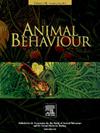Male bushcrickets show context-dependent plasticity in temporal signal features during acoustic contests
IF 2.3
2区 生物学
Q2 BEHAVIORAL SCIENCES
引用次数: 0
Abstract
Males of sound-communicating species typically emit acoustic signals both to attract mating partners and compete against rival males. Temporal properties of these signals convey information about the males’ condition and quality as potential mates. Previous studies on acoustic competition in bushcrickets have shown that temporal features are plastic and may vary depending on male body condition and social context, including the distance, number and quality of competitors. Prolonged acoustic contests may also prompt signalling males to modify their calling behaviour over time. To investigate context-dependent behavioural plasticity in bushcrickets, we analysed the temporal properties of Poecilimon ampliatus male signals, specifically verse duration, verse number and duty cycle, in relation to their social environment, body mass as a predictor of body condition and the time spent in signalling competition. Males from two distinct body mass classes, light and heavy, were tested at the beginning and the end of a 50 min recording period under two conditions: a playback experiment simulating competition with a strong rival and no playback. Regardless of their body mass, P. ampliatus males adjusted temporal signal features depending on the social context, promptly increasing their signalling effort under competition compared with isolation. However, behaviourally plastic responses of light males to competition also varied over time, likely due to tradeoffs imposed by prolonged competitive signalling. These findings highlight the importance of adaptive signal modifications in mediating competitive interactions in bushcrickets, with potential implications for female choice.
雄蟋蟀在声音竞争中表现出情境依赖性的时间信号特征可塑性
声音交流物种的雄性通常会发出声音信号来吸引配偶并与竞争对手竞争。这些信号的时间特性传达了雄性作为潜在配偶的条件和质量的信息。先前对蟋蟀声音竞争的研究表明,时间特征是可塑的,可能会根据雄性的身体状况和社会环境而变化,包括竞争对手的距离、数量和质量。长时间的声音竞争也可能促使发出信号的雄性随着时间的推移改变它们的叫声行为。为了研究丛林蟋蟀的情境依赖性行为可塑性,我们分析了雄性蟋蟀信号的时间特性,特别是诗的持续时间、诗的数量和占空比,以及它们的社会环境、作为身体状况预测因子的体重和在信号竞争中花费的时间。在50分钟的录音开始和结束时,对体重不同的两种雄性动物进行了测试:模拟与强对手竞争的回放实验和不回放实验。不管它们的体重如何,放大p.a rapiatus雄性根据社会环境调整时间信号特征,与孤立相比,在竞争中迅速增加它们的信号努力。然而,浅色雄性对竞争的行为可塑性反应也随着时间的推移而变化,这可能是由于长时间的竞争信号所带来的权衡。这些发现强调了自适应信号修改在调节蟋蟀竞争相互作用中的重要性,并对雌性选择有潜在的影响。
本文章由计算机程序翻译,如有差异,请以英文原文为准。
求助全文
约1分钟内获得全文
求助全文
来源期刊

Animal Behaviour
生物-动物学
CiteScore
4.60
自引率
8.00%
发文量
236
审稿时长
10.2 weeks
期刊介绍:
Growing interest in behavioural biology and the international reputation of Animal Behaviour prompted an expansion to monthly publication in 1989. Animal Behaviour continues to be the journal of choice for biologists, ethologists, psychologists, physiologists, and veterinarians with an interest in the subject.
 求助内容:
求助内容: 应助结果提醒方式:
应助结果提醒方式:


